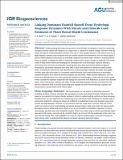| dc.contributor.author | Ross, C. A. | |
| dc.contributor.author | Casson, N. J. | |
| dc.contributor.author | Tenuwara, M. | |
| dc.date.accessioned | 2021-08-23T21:36:51Z | |
| dc.date.available | 2021-08-23T21:36:51Z | |
| dc.date.issued | 2021-08-21 | |
| dc.identifier.citation | Ross, C. A. , N. J. Casson, and M. Tenuwara. "Linking dominant rainfall-runoff event hydrologic response dynamics with nitrate and chloride load estimates of three boreal Shield catchments." Journal of Geophysical Research: Biogeosciences, 126 (2021): e2020JG006187. DOI: 10.1029/2020JG006187. | en_US |
| dc.identifier.issn | 2169-8953 | |
| dc.identifier.uri | https://hdl.handle.net/10680/1963 | |
| dc.description | | en_US |
| dc.description.abstract | Understanding hydrological dynamics in boreal Shield catchments is critical for projecting changes in stream runoff and chemistry in a region that is sensitive to climate change. Previous work has mostly focused on a limited number of events over one or a few seasons because of the relative scarcity of high-frequency datasets and automated tools for rainfall-runoff event delineation. For the boreal region, a greater understanding of seasonality in hydrologic response and solute export related to rainfall-initiated events is needed, as significant shifts in hydrologic regime from climate change are expected. This study aimed to help resolve these knowledge gaps by assessing event-scale hydrologic response dynamics and stream loads of nitrate and chloride using long-term data from three boreal Shield catchments. Hydrometric and stream chemistry data from 2001-2018 were analyzed to delineate rainfall-runoff events and estimate event nitrate and chloride loads. Event hydrologic response and loads were highly variable, especially with respect to catchment runoff initiation. Only subtle differences in hydrologic response dynamics were observed between summer and fall events, while seasonal differences in event nitrate and chloride loads were mostly statistically significant. Interestingly, a wide range of rainfall-runoff events classified by response magnitude and timing were associated with differences in nitrate and chloride export. This study further confirms the utility of long-term high-frequency datasets and illustrates the need for additional work to further assess long-term changes in event-based hydrologic response and stream solute concentrations in the boreal region. | en_US |
| dc.description.sponsorship | "This work was funded by an NSERC Discovery Grant to NJC." | en_US |
| dc.description.uri | https://agupubs.onlinelibrary.wiley.com/doi/10.1029/2020JG006187 | en_US |
| dc.language.iso | en | en_US |
| dc.publisher | American Geophysical Union | en_US |
| dc.rights | info:eu-repo/semantics/openAccess | en_US |
| dc.title | Linking dominant rainfall-runoff event hydrologic response dynamics with nitrate and chloride load estimates of three boreal Shield catchments | en_US |
| dc.type | Article | en_US |
| dc.identifier.doi | https://doi.org/10.1029/2020JG006187 | en_US |

